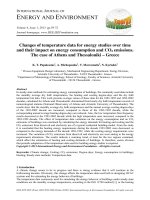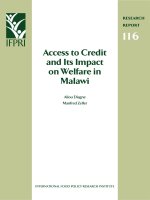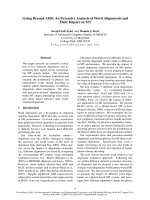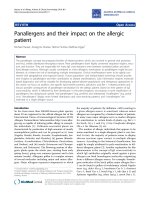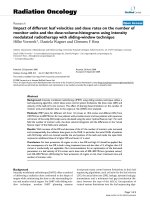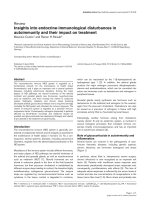Modern approaches to floristics and their impact on the region of SW Asia
Bạn đang xem bản rút gọn của tài liệu. Xem và tải ngay bản đầy đủ của tài liệu tại đây (165.13 KB, 10 trang )
Turk J Bot
28 (2004) 7-16
© TÜB‹TAK
Modern Approaches to Floristics and Their Impact on the
Region of SW Asia
Vernon HEYWOOD
Centre for Plant Diversity and Systematics School of Plant Sciences The University of Reading, Reading RG6 6AS UK
Received: 05.11.2002
Accepted: 29.01.2003
Abstract: Attitudes to floristics have changed considerably during the past few decades as a result of increasing and often more
focused consumer demands, heightened awareness of the threats to biodiversity, information flow and overload, and the application
of electronic and web-based techniques to information handling and processing. This paper will examine these concerns in relation
to our floristic knowledge and needs in the region of SW Asia. Particular reference will be made to the experience gained from the
Euro+Med PlantBase project for the preparation of an electronic plant-information system for Europe and the Mediterranean, with
a single core list of accepted plant names and synonyms, based on consensus taxonomy agreed by a specialist network. The many
challenges – scientific, technical and organisational – that it has presented will be discussed as well as the problems of handling nontaxonomic information from fields such as conservation, karyology, biosystematics and mapping. The question of regional
cooperation and the sharing of efforts and resources will also be raised and attention drawn to the recent planning workshop held
in Rabat (May 2002) for establishing a technical cooperation network for taxonomic capacity building in North Africa as a possible
model for the SW Asia region.
Key Words: floristics, SW Asia, electronic inventory, networking, Euro+Med PlantBase
If we are to protect biodiversity, we must understand it, and to understand it, we must cooperate in a worldwide fashion. Such
efforts are essential if the globalisation of Nature is to benefit our society.
Kress et al., 2002
Introduction: the international context
Although frequent resolutions have been passed by
congresses and symposia during the past 50 years,
drawing attention to the fundamental importance of a
knowledge of the taxonomy of organisms for other
branches of science and learning and for society, while at
the same time lamenting the current state of taxonomic
studies and the shortage of taxonomists, little effective
action has been taken by governments to alleviate this
situation. Recently, however, under the auspices of the
Convention on Biological Diversity, the importance of
taxonomy and floristic studies has been recognised by the
Parties (i.e. the signatory countries), who recognised that
the combination of inadequate taxonomic knowledge, the
shortage of systematists and the inadequacy of sampling,
collections, human resources and infrastructure
constituted a ‘taxonomic impediment’ as regards
implementation of the Convention on Biological Diversity.
Largely as a consequence of the process of
implementing the Convention on Biological Diversity, the
need for taxonomic knowledge as a means of
underpinning biodiversity conservation is now widely
accepted by governments. For example, a recent report,
What on Earth? The Threat to the Science Underpinning
Conservation (2001), issued by the UK House of Lords
Select Committee on Science and Technology concluded
‘Taxonomic data are fundamental to conserving
biodiversity. Taxonomists are needed to provide
conservationists with tools to identify and therefore
monitor the prevalence of species, by indicating which
species are near extinction and by indicating areas of the
world with high diversity that should be conserved’. This
involves continuing the inventory of plant diversity and
various kinds of floristic studies as discussed below.
The Conference of the Parties (COP) has endorsed a
‘Global Taxonomy Initiative’ (GTI) to improve taxonomic
7
Modern Approaches to Floristics and Their Impact on the Region of SW Asia
knowledge and capacity to further country needs and
activities for the conservation, sustainable use and
equitable sharing of the benefits of biodiversity. At the
Sixth Meeting of the Conference of the Parties (COP) to
the Convention on Biological Diversity held in The Hague
in April 2002, a programme of work (Box 2) for the
Global Taxonomy Initiative was agreed (Decision VI/8).
Although as Blackmore (2002) points out, prospects are
not good for the first and most fundamental challenge –
a global inventory of life on Earth, as called for by some
biologists – for plants the situation is more hopeful.
Box 1: Global Taxonomy Initiative
The GTI has been established under the Convention on
Biological Diversity to underpin decision making in
conservation of biological diversity, sustainable use of its
components and equitable sharing of the benefits derived
from the utilisation of genetic resources, by addressing:
(a)
The lack of taxonomic information on the identity
of components of biological diversity in many
parts of the world; and
(b)
The need to build capacity for taxonomic activity
in all regions, but especially developing countries,
including reference materials, databases, and
taxonomic expertise relevant to the objectives of
the Convention on Biological Diversity
A ‘Global Strategy for Plant Conservation’ (Decision
VI/9) was also adopted at COP VI, with a set of targets
for the year 2010, including [Target 1]: ‘A widely
accessible working list of known plant species, as a step
towards a complete world flora’. Discussions are
proceeding about how to achieve this target but it is
certainly easier to produce a global list for plants species
than for most other groups of organism, given that so
many major floristic projects have been completed in
recent years or are well underway (e.g. Flora Europaea,
Flora Mesoamericana, Flora of North America, Flora of
Australia, Flora Malesiana), as well as Check Lists for
regions or countries such as Med-Checklist, Enumeration
des Plantes à Fleurs d’Afrique Tropicale and Catalogue of
the Vascular Plants of Ecuador, and global compilatory
projects such as the Species Plantarum Project, the Global
Plant Checklist Project and Species 2000.
Inventory and floristic studies are only a beginning
and it has to be remembered that even for such wellstudied groups as the Flowering Plants little is known of
the majority of species apart from some basic facts of
8
their morphology and localisation: for most of them, their
demography, reproductive biology, breeding system,
genetic variability and so on is unstudied. Yet the fact is
that for many of the purposes of biodiversity assessment
and conservation – for example, in the management of
endangered species – information is required beyond
identification and description of the species, such as data
on the breeding system and demography of its
populations.
Box 2: Global Taxonomy Initiative Programme of
Work (source CBD, 2002)
The programme of work consists of five operational
objectives:
Operational objective 1: Assess taxonomic needs and
capacities at national, regional and global levels for the
implementation of the Convention.
Operational objective 2: Provide focus to help build
and maintain the human resources, systems and
infrastructure needed to obtain, collate and curate the
biological specimens that are the basis for taxonomic
knowledge.
Operational objective 3: Facilitate an improved and
effective infrastructure/system for access to taxonomic
information; with priority on ensuring that countries of
origin gain access to information concerning elements of
their biodiversity.
Operational objective 4: Within the major thematic
work programmes of the Convention, include key
taxonomic objectives to generate information needed for
decision making in conservation and sustainable use of
biological diversity and its components.
Operational objective 5: Within the work on crosscutting issues of the Convention, include key taxonomic
objectives to generate information needed for decision
making in conservation and sustainable use of biological
diversity and its components
However, words are not enough and what counts is
action on the ground. The challenge for all of us is to
ensure that these aspirations and good intentions are
translated into effective action. Taxonomists and
systematists of all persuasions must ask themselves just
how they should react to the alarming situation regarding
the continuing loss of biodiversity which is widely
reported. Part of the solution depends on the availability
of additional finance directly by governments or in the
V. HEYWOOD
case of developing countries through mechanisms such as
the Global Environment Facility, and other agencies and
through aid programmes. However, a significant part of
the solution also lies in the hands of taxonomists
themselves through more effective planning, better
cooperation, better use of existing resources, better
targeted projects, and more use of EDP (cf. Heywood,
2001).
Changing paradigms in taxonomy and
systematics: the twin need of inventory and
phylogeny
It is somewhat ironic that just as governments are
beginning to recognise the basic need for alpha
taxonomy, as reflected in the CBD and other instruments,
the whole field of taxonomy and systematics is
undergoing a major reassessment. Enormous changes
have taken place in the methodology of systematics in the
past 10–15 years through, on the one hand, the
widespread application of cladistic methodology (whether
pattern or phylogenetic) and the use of molecular
characters, and on the other hand, the increasing use of
electronic data processing and web-based approaches in
floristic and taxonomic work. Even the herbarium has not
escaped this period of change and I suspect that in 50
years’ time it will be no longer recognisable either in form
or in function.
The enormous advantage of molecular taxonomy is of
course the high degree of ‘objectivity’ of the data
obtained: unlike morphological characters, there is no
ambiguity about their definition. DNA sequences of the
chloroplast genes such as rbcL and atpB, restriction site
variation and changes in intron presence or gene order
provide useful characters for phylogenetic reconstruction
and the data are therefore handled cladistically. Many
impressive data sets are available in the literature as a
perusal of journals such as Systematic Botany and Plant
Systematics and Evolution will soon reveal and numerous
proposals have been made for the revision of currently
accepted relationships at the supraspecific level in the
flowering plants such as the ordinal classification for the
families of flowering plants published by the Angiosperm
Phuylogeny Group (APG). While there are still serious
problems of interpretation and issues such as congruence
of data sets to be resolved, a great deal of light has been
shed on the relationships between and within a number
of families.
As a result of the increasing use of these techniques,
it can be observed that a large part of taxonomists’ time
is spent either in the laboratory or sitting at computer
screens analysing data. Moreover, it is unfortunate that in
a number of the papers published in this area a great deal
of information is given about techniques and
methodology but relatively little about the taxonomic
characteristics or biology of the plants themselves
(Heywood, 1999). Indications of a putative phylogenetic
relationship have become for some systematists more the
focus of the research rather than the phenetic
characteristics of the plants themselves.
As I have previously commented (Heywood 1999),
one of the issues being debated in systematics today is
how far the conceptual changes that have been widely
applied at the higher taxon level, such as the theory and
methodology of phylogenetic reconstruction and the
acceptance of monophyly as a necessary attribute of
higher taxa, coupled with the use of macromolecular
characters, are applicable at the species level and below.
With the development of phylogenetic theory, a number
of biologists are looking at the boundary areas between
hierarchic and reticulate descent relationships, since
phylogenetics is a means of analysing relationships in
hierarchic systems, and this boundary area therefore
represents the limits of phylogenetics (Davis, 1995).
Species are groups that fall into this boundary area since
they do not contain subunits that are related to each
other hierarchically although the relationships between
species may be.
What then are we to make of the fact that there is
now more confusion in the literature on species concepts
than even in Darwin’s day? Despite their unique role in
both biological classification and biological diversity, there
is no universal agreement on how to define a species and
the actual named species we handle in biodiversity studies
are comparable only by designation not in terms of their
degree of evolutionary, genetic, ecological or phenetic
differentiation (Heywood, 1994). Today there are
currently at least seven or eight different species concepts
in use (phenetic, biological, recognition, ecological,
cladistic, pluralistic, phylogenetic and evolutionary) and
no agreement has been reached on how to develop a
coherent theory of systematics at the species level (see
the series of papers on species concepts in Systematic
Botany volume 20, Number 4 1995). In addition, species
concepts differ from group to group and there are often
9
Modern Approaches to Floristics and Their Impact on the Region of SW Asia
national or regional differences in the way in which the
species category is deployed (Heywood, 1991) which
make comparisons difficult. As May (1995) comments,
‘The varying concepts in different groups, and indeed
within a single group, are a major cause of uncertainty
intrinsic to all aspects of biodiversity research that use the
species as a standard unit.’
In the current debate over phylogenetic species and
the use of cladistically defined classifications, the criticism
is often levelled at conventional biological classifications
that they are imprecise and poorly specified (Langer,
2001). How far is this a serious concern for user
communities? Differing species concepts pose problems,
as Gaston (1996) notes, from the point of view of
biodiversity studies: for example, we need to ensure that
for any given higher taxon, the same species concept has
been applied when making comparisons of species
numbers in different areas. How often is this in fact
possible? The fact is that the vast majority of species have
been described and recognised using morphological or
phenetic criteria. In the light of present circumstances,
the magnitude of the task, the availability of resources,
the degree of sampling; this is the best that can be done.
The answer seems to be that in many cases the level of
specification needed by the different user groups is so
general that this is not a serious handicap. In other cases,
precise measures are needed if meaningful comparisons
are to be made.
Consumer demands
One of the major changes in attitudes to taxonomy
and floristics has come from increasingly explicit and
specific user needs (Heywood, 2001). Taxonomists
should be aware of the nature of the demands for
information that are being made not only by other
biologists, but by policy-makers and planners for the
management for sustainability of our environment, and
for meeting the demands of a growing world population
for food and fuel. The kind of questions that are being
asked today by governments concern not just what plant
grows where, fundamental though that may be, but, for
example, what are the effects going to be on biodiversity
(in terms of genes, taxa, ecosystems and agroecosystems,
landscapes) of changes in climate, large-scale movements
of populations leading to population increase in some
areas or decrease in others, and changes in global and
regional agricultural and forestry policies; which species
can be identified as indicators of biodiversity or
10
ecosystem health? Increasingly, and perhaps this has
always been so, taxonomy is seen by many of its users
(apart from other taxonomists) as a means to an end.
So, in developing and strengthening the taxonomic
base, consideration should be given to the information
needs for different activities that depend on taxonomy,
e.g., bioprospecting, wild harvesting of species, habitat
conservation, sustainable agriculture and the sustainable
use of biological resources.
SW Asian region
The SW Asia region is not unambiguously defined,
either politically, biogeographically or floristically. It is
largely coextensive with what is often called the Middle
East or the Near East and as Frodin (2001) notes in his
Guide to the Standard Floras of the World, it largely
coincides with the area covered by Boissier in his Flora
Orientalis. It is the crossroads where two great floristic
kingdoms meet – the Holarctic and the Palaeotropical
and, as Boulos et al. point out, all the major phytochoria
found in SW Asia extend into surrounding regions or are
in fact centred outside the region.
In terms of floristics, it is a region where despite the
fact that a number of standard or even landmark Floras
have been produced recently such as Flora Iranica, Flora
of Turkey, Flora of Cyprus, Nouvelle Flore du Liban et de
la Syrie, Flora Palaestina, Flora of Iraq, Flora of Pakistan
and (in progress) and Flora of the Arabian Peninsula,
much work on the taxonomy and distribution of the
plants remains to be done. As Frodin (2001) points out,
many of these Floras are essentially prodromi or
preliminary accounts of rather poorly known territories.
A summary of the floristic data of this region was
prepared for the Centres of Plant Diversity Project by
Boulos et al. (1994) as shown in Table 1. It is difficult to
calculate the overall total number of species for the
region but according to Boulos et al. (1994) it comprises
some 23,000 vascular plant species of which 6,700 are
endemic to the region. On the other hand, the flora of the
Middle East is estimated at 15,000 species by Heller
(1991). Figures for floristic richness and endemism are
given for individual countries in Table 2. These figures
can be compared with 25–30,000 species for the flora of
the Mediterranean region.
What then are the needs and prospects for the
region? Firstly, as already mentioned, a major
desideratum is to complete the inventory of the flowering
V. HEYWOOD
Table 1. Floristic diversity in the countries of the Near East and SW Asia (Boulos et al., 1994).
Country
Vascular plant species
Bahrain
Endemic species
% Endemic species
248
0
0.0
Egypt
2121
54
7.2
Iran
8000
1400
17.5
Iraq
3000
190
6.3
Israel
2225
165
7.4
Jordan
2100
145
7.3
Kuwait
282
0
0.0
Lebanon
2600
311
12.0
Oman
1200
73
6.1
Qatar
306
0
0.0
Saudi Arabia
2028
34
1.7
Sinai (Egypt)
984
30
3.1
Syria
3100
395
13.0
Turkey
8650
2675
30.9
United Arab Emirates
Yemen
Socotra (Yemen)
340
0
0.0
2830
135
4.8
815
230-267
28.2-32.7
Table 2. Floristic richness and endemism in SW Asian phytochoria.
Phytochorion
Area (km2)
Vascular
plant species
Irano-Turanian
2,400,000
17,000
5100
30
80
Mediterranean
175,000
3-4000
600-800
20
3-4
Somali-Masai
375,000
1800
500
28
16
Sahara-Sindian
Endemic
species
% Species
endemism
Endemic
genera
3,600,000
1500
100
7
6
Afromontane
60,000
400
55
14
1
Euro-Siberian
160,000
4000
500
12
5
30,000
1200
50
4
10
Indo-Himalayan
plants and ferns and to ensure that the standard Floras in
progress are expeditiously brought to a successful
conclusion. The second requirement, in common with
most other regions of the world, is to consider what
system can be put in place to maintain the floristic
knowledge up to date and at the same time institute a
mechanism whereby associated information can be
gathered and stored systematically. This leads us on to
considerations of electronic approaches to floristics and
taxonomy.
Electronic approaches to floristics
The application of informatics techniques to floristics
is beginning to transform the way that taxonomists work
in assembling, circulating and reviewing data. After a
number of false starts, electronic web-based preparation
and publication of floristic and taxonomic projects, in the
form of continually updated information systems and
databases is beginning to replace conventional time- and
information-limited Floras and, to a lesser extent,
monographs. This electronic approach will also greatly
11
Modern Approaches to Floristics and Their Impact on the Region of SW Asia
expand the range of outputs possible and thereby have a
significant effect on improving access to floristic data
(Heywood, 2001). It will also encourage an expansion of
the fields hitherto considered in floristic projects so that
related areas, such as conservation data (cf. Golding &
Smith, 2001), detailed mapping, phytochemistry, ecology
and phytosociology and reproductive biology, will be
included, either directly or by computer linkages. As an
example, the Euro+Med PlantBase project will be
outlined.
Euro+Med PlantBase
The Euro+Med PlantBase project is highly relevant in
this context as it overlaps with the Middle East/SW Asia
region. Euro+Med PlantBase is a regional initiative that
involves all the countries of Europe and the
Mediterranean region. The first phase has been funded by
the European Community under Framework V and
involves the establishment of structures, the completion
of an electronic catalogue of all the flowering plants and
ferns of the region, the preparation of the necessary
protocols and software, the design of verified summaries
(‘beads’) of information on karyology and biosystematics,
conservation, mapping and distributions, and taxonomic
revision (Fig. 1). A mechanism for the regional
cooperative revision of the taxonomic status of all
families, genera, species, subspecies and, where
appropriate, cultivars described from the EuroMediterranean region has been developed. The
organisation of this work will involve specialists from
over 50 countries and territories within the region. This
revisionary process will result in an agreed taxonomic
core, which will be one of the main outputs of the project.
Networks of Regional and National Centres, Associated
Centres, Taxonomic Centres, Thematic Specialists and
Authors have been established throughout the region
(Fig. 2).
EURO
MED
PlantBase
Taxonomic
Core
Summary
Beads
Satellite
databases
Figure 1. The basic structure of the Euro+Med Plant Base.
12
V. HEYWOOD
Figure 2. Structure of the Euro+Med Plant Base organization.
The idea of the Euro+Med PlantBase gradually
evolved out of a number of earlier initiatives and the
changing context of taxonomy and systematics. A key
factor was the Flora Europaea project that was
formulated in the post-war context and aimed at
providing a modern synthesis of the enormous diversity
of taxonomic information and opinions that was scattered
in a ‘vast accumulation of literature, published in many
places and in a variety of languages, much of which is
inaccessible…’ The successful publication of Flora
Europaea lead to a continental view of the flora of Europe
– a synthesis and consensus, arrived at after extensive
consultation through a network of regional advisers.
On a recommendation of the Joint Committee of the
Nordic Science Research Councils (NOS) and of The Royal
13
Modern Approaches to Floristics and Their Impact on the Region of SW Asia
Society of London, the Standing Committee of the
European Research Councils (ESRC) decided in 1975 to
propose the setting up of an ad hoc group in taxonomy.
The European Science Foundation gave its full support
and the ESRC ad hoc group on Biological Recording,
Systematics and Taxonomy was established. A proposal
on how to proceed was drawn up by Professors R B Clark
and V H Heywood in consultation with The Royal Society
and the Natural Environment Research Council. An
Interim Report was published in 1977 and the Final
Report, Taxonomy in Europe (eds. V.H. Heywood and
R.B. Clark), in 1982.
These Reports included surveys of the then situation
of systematic botany and taxonomy in Europe and
recommendations for research priorities and identified a
number of research priorities. These latter included for
plants:
European floristic information system
Coordination of research and information on the
biosystematics of European plants
Extension of the work of the Threatened Plants
Committee of IUCN
Check-list of the flora of the Mediterranean basin.
It was decided to unite the first two of these
proposals as Project I: European Floristic, Taxonomic and
Biosystematic Documentation System (ESFEDS), of an
Additional Activity in Taxonomy that was approved by the
Assembly of the European Science Foundation in
November 1979.
The European Taxonomic Floristic and Biosystematic
Documentation System (ESFEDS) project was undertaken
principally at the University of Reading and was
essentially an electronic compendium of specified fields of
information using Flora Europaea as a base-line. All the
basic data, except descriptions, were extracted from Flora
Europaea and stored in a custom-designed computerised
database (Heywood et al., 1984).
A major component of the project was the design of
methodologies for gathering and storing electronically
additional data fields on biosystematics, phytochemistry,
ecology, phytosociology, cytology, conservation status,
illustrations, and literature. Substantial progress was
made in this regard before the project had to be
discontinued due to lack of funds. In addition, novel
methods such as a user-friendly interface for presenting
such information were tested.
14
Check-list production was one of the outputs possible
from the database, and lists of taxa and synonyms, with
or without additional information, could be produced for
any of the 41 European territories. Lists for Albania,
Bulgaria, Spitzbergen and the Azores were amongst
those that were produced in a format ready for
publication. A Checklist of European Pteridophytes was
the first major updated output to be produced directly
from the ESFEDS database (Derrick et al., 1987). In the
Preface I wrote ‘In offering this checklist to the public we
feel confident that a breakthrough has been made in
botanical documentation and the time brought nearer
when electronically produced, continually updated
information will become regularly available as part of the
international biological scene’.
The data stored in the hierarchical framework were
later transferred to the University of Reading mainframe
computer and stored within a relational framework in
ORACLE. Later the ESFEDS database was transferred to
the Royal Botanic Garden Edinburgh, UK, where it was
curated and transferred to PANDORA by Dr Richard
Pankhurst. Data from the revised edition of volume 1 of
Flora Europaea were incorporated and numerous other
technical changes and corrections made to the database.
The ESFEDS database has been widely used since its
completion and copies have been requested by institutions
and organisations around the world. It provided an
obvious starting point for the Euro+Med PlantBase and
has now been superseded by the Euro+Med Database.
The essence of the E+M PlantBase is that it is an
open-ended electronic database and information system
that, unlike a conventional taxonomic publication such as
a Flora, is not aimed at producing a single fixed output. It
is true that particular outputs are envisaged in phase I of
the project such as a synonymic catalogue of the
European flora, a first draft catalogue of the flora of the
whole of the Euro+Mediterranean region, and samples of
taxonomic revisions of selected groups, but once up and
running, particular outputs of various kinds and
combinations of data can be requested, and of course the
data extracted will be as up to date as the database itself.
It combines electronic means of data storage and
handling with the essential mechanism of review by
specialists of taxonomic, chorological, and other kinds of
data and this will be undertaken in due course as a webbased operation. It will depend of course on the
V. HEYWOOD
availability of taxonomic specialists to undertake revisions
at various levels, either specifically for the project, or
through the normal means of publication, and the aim is
that when the latter become available the information
they include will be included into the database as soon as
human resources permit. Thus the perennial problem of
Floras and revisions becoming out of date almost as soon
as they are published will be obviated.
Of course this approach to taxonomic and floristic
compilation is as dependent as the more conventional
approaches used hitherto on the availability of continuing
finance and it is well known that in most fields of
endeavour it is easier to obtain finance for designing and
developing databases than for maintaining them. There is
no doubt, however, that we can make a much better case
for support for such Web-based taxonomic systems than
the present approach of long-term, open-ended,
conventional, non-electronic compilations that do not
necessarily address the needs of users in a timely fashion
nor present the information in as approachable a format
as possible. The future of a Web portal to access hard
data supplied by scientific professionals is as inevitable in
the area of plant and animal systematics as it is in other
fields of human endeavour.
Problems, some of them quite complex, such as
intellectual property rights and access to information and
reward systems for contributors to such information
systems and databases have to be addressed. Open Web
access to valuable content created by others, as Wilson
(2001) recently pointed out, ‘introduces potential
problems of “authority”, i.e. ownership, quality control,
plagiarism and simple theft’. He goes on to say that ‘The
transition from traditional paths of data flow to the Web
environment will involve basic changes in scientific
culture. … Adaptive change required for active
disciplinary engagement with the new medium will force
significant redefinitions of community objectives,
priorities, and also the production of new interactive
protocols.’ And he concludes that ‘Given the long cultural
lineage and rich history of plant systematics, movement
across the digital threshold will be difficult and probably
slow.’
The importance of networking
The Global Taxonomy Initiative draws attention to the
desirability of networking and increased cooperation
between individuals, institutions, organisations and
countries. A recent example that may be relevant for the
SW Asian area is the the proposed North African
taxonomic network, NAFRINET. A proposal to North
African Governments for the establishment of a North
African Loop of BioNET-INTERNATIONAL, known as
NAFRINET, was produced by a workshop held on 12-16
May 2002, at the Institut Agronomique et Vétérinaire
Hassan II, Rabat, Morocco. It was organised by the
Institut Agronomique et Vétérinaire Hassan II, Rabat,
Morocco, the Euro+Med PlantBase Project and the
Technical Secretariat of BioNET-INTERNATIONAL.
The Workshop was attended by a total of 30
participants: national representatives from each potential
NAFRINET Member country, i.e. Algeria, Egypt, Libya,
Mauritania, Morocco and Tunisia; two resource persons
from the BioNET-INTERNATIONAL Technical Secretariat,
UK; one person as Acting Programme Officer - Global
Taxonomy Initiative (GTI) of the Convention on Biological
Diversity (CBD) Secretariat, Montreal, Canada; a
representative from the Secretariat of WAFRINET, the
West AfricanLOOP of BioNET-INTERNATIONAL, and
observers from IUCN, FAO, OPTIMA, Euro+Med
PlantBase and MEDUSA.
The full costs of the workshop were covered by a
grant from the UK Department for International
Development (DFID).
The goals of the Workshop were to:
formulate a detailed proposal for the establishment of
a Technical Cooperation Network (TCN) for taxonomic
capacity building in the North African region;
debate and agree on TCN structures to best
strengthen capacity building, collaboration and
networking among and between member countries and
their relevant institutions;
develop a strategic plan for subregional taxonomic
capacity building that meets the needs of national
sustainable development programmes and National
Biodiversity Strategy and Action Plans including:
develop a shared vision for pooling, sharing and
optimising subregional expertise, information, records,
collections, infrastructure and technologies for the
further enhancement of taxonomic capacity in the
subregion; and draft programmes of work to meet the
identified taxonomic capacity needs of regional and
national development and biodiversity management plans,
15
Modern Approaches to Floristics and Their Impact on the Region of SW Asia
including the required support for implementation of
international environmental conventions, for example, the
Convention on Biological Diversity (CBD), the
International Plant Protection Convention (IPPC) and
other initiatives such as the Global Invasive Species
Programme (GISP)
The
Workshop
participants
unanimously
recommended that the Institut Agronomique et
Vétérinaire Hassan II be the Network Coordinating
Institute (NECI). This is also the Regional Centre for the
Euro+Med PlantBase project, which looks forward to
developing joint proposals with NAFRINET.
Conclusion
The future development of floristic and taxonomic
studies in SW Asia will be greatly influenced by the
application of bioinformatics techniques and electronic
Web-based systems which will make the gathering and
synthesis of data more efficient and facilitate the delivery
of products that are timely and tailor-made for the
consumer. Such approaches should cover a range of fields
such as conservation, biosystematics, plant chemistry,
and distribution mapping as well as strictly taxonomic
data. Effective networking will also facilitate the process.
The proposals have been submitted to the
governments of the NAFRINET member countries for
formal approval.
References
Blackmore S (2002). Biodiversity Update–Progress in Taxonomy.
Science 298: 365.
Boulos L, Miller AG & Mill RR (1994). Regional overview: South West
Asia and the Middle East. In: Davis SD, Heywood VH & Hamilton
AC (eds). Centres of Plant Diversity. A guide and strategy for their
conservation. Volume 1: Europe, Africa, South West Asia and the
Middle East, pp.293–308. WWF and IUCN. Cambridge UK: IUCN
Publications Unit.
CBD
(2002). Convention on Biological Diversity. www.
biodiv.org/programmes/cross-cutting/ taxonomy/decisions.asp
Davis JI (1995). Species concepts and phylogenetic analysis –
introduction. Syst Bot 20: 555-559.
Derrick LN, Jermy AC & Paul AM (1987). Checklist of European
Pteridophytes. Sommerfeltia 6: 11-94.
Frodin DG (2001). Guide to the standard floras of the world, ed. 2.
Cambridge: Cambridge University Press.
Gaston KJ (1996). Species richness: measure and measurement. In:
Gaston KJ (ed.) Biodiversity: A biology of numbers and difference,
pp. 77-113. Oxford: Blackwell Science.
Golding JS & Smith PP (2001) A 13-point flora strategy to meet
conservation challenges. Taxon 50: 475-477.
Heller D (1991). Conspectus Florae Orientalis. Botanica Chronica 10:
55–61.
Heywood VH (1991). Needs for stability of nomenclature in
conservation. In: Hawksworth D (ed), Improving the Stability of
Names: needs and options, pp.53–58. [Regnum Vegetabile No.
123]. Königstein: Koeltz Scientific Books.
Heywood VH (1994). The measurement of biodiversity and the politics
of implementation. In: Forey PL, Humphries CJ & Vane-Wright RI
(eds). Systematics and Conservation Evaluation, pp. 15–22.
Oxford: Clarendon Press.
16
Heywood VH (1998). The species concept as a socio-cultural
phenomenon – a source of the scientific dilemma. Theory Biosci
117: 203–212.
Heywood VH (1999). The importance of inventory in biodiversity
studies. In: Tandon RK & Prithipalsingh (eds). Biodiversity,
Taxonomy and Ecology, pp. 65-82. Jodhpur (India): Scientific
Publishers.
Heywood VH (2001). Floristics and monography–an uncertain future?
Taxon 50: 361–380.
Heywood VH (2003). (in press). The future of floristics in the
Mediterranean region. Israel Journal of Plant Science 51:
Heywood VH, Moore DM, Derrick LN, Mitchell KA & van Scheepen J
(1984). The European taxonomic, floristic and biosystematic
documentation system—an introduction. In: Allkin R & Bisby FA
(eds). Databases in Systematics, pp. 79–89. Academic Press:
London.
The Global Taxonomy Initiative: Using Systematic Inventories to Meet
Country and Regional Needs. A Report of the
DIVERSITAS/Systematics Agenda 2000. International Workshop
September 17-19, 1998. American Museum of Natural History,
New York.
Kress WJ, O’Connor JD & DePriest P (2002). The Globalization of
Nature. Science 296: 1612.
Langer MC (2001). Linnaeus and the PhyloCode: where are the
differences? Taxon 50: 1091.
May RM (1995). Conceptual aspects of the quantification of the extent
of biological diversity. In: Hawksworth DL (ed). Biodiversity
Measurement and Estimation 13– 20. London: Chapman and Hall,
in association with The Royal Society.
Wilson HD (2001). Informatics: new media and paths of data flow.
Taxon 50: 381-387.
